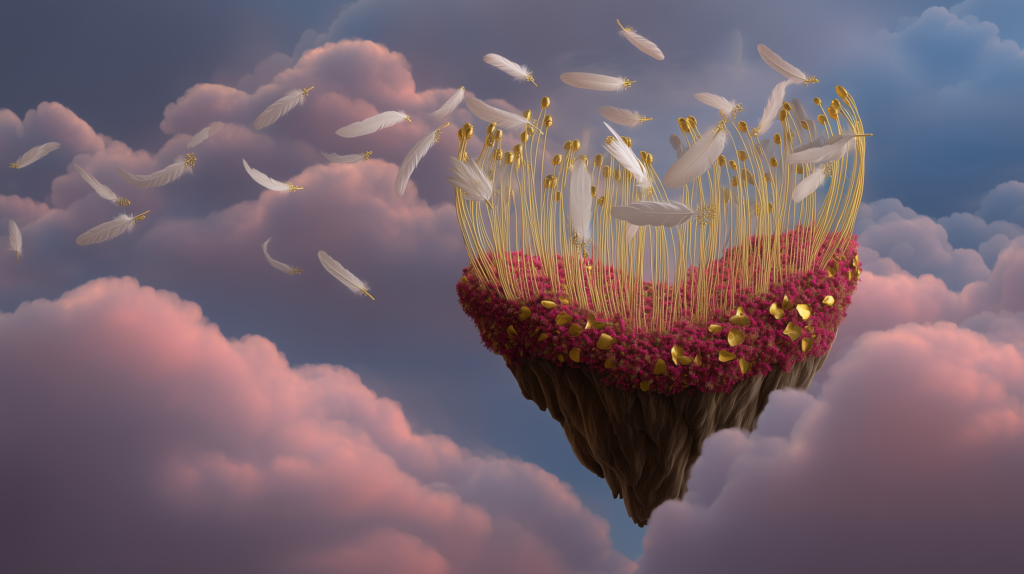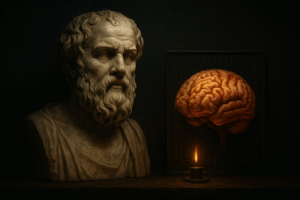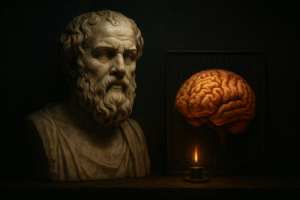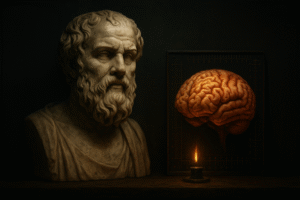A Practical Guide to Self-Mastery

Inspired by the teachings of The Monk Who Sold His Ferrari, this blog is not just a text — it’s a map for inner transformation. Here you’ll find practical ideas, powerful metaphors, and rituals that help rebuild your mind, body, and spirit from the center: your own presence.
Introduction — What does it really mean to transform your life?
We live surrounded by empty promises of change. The self-help industry is saturated with recycled motivational quotes, instant happiness formulas, and generic methods that seem to work for everyone — except you.
But… what if there was a simple, deep, and radically transformative path?
At some point, we all feel the same discomfort: we’re too busy with soulless tasks, sacrificing what matters most — our children, our health, our dreams — in exchange for goals that never truly satisfy. Deep down, what we long for is clarity, energy, and meaning.
But where do we begin?

This blog presents a practical model for inner reconstruction, based on the teachings of The Monk Who Sold His Ferrari by Robin Sharma. It is not a summary of the book. It is a living application — a synthesis of its 13 chapters, 7 essential principles, and 10 rituals of radiant living, translated into concrete actions that I have personally lived, tested, adapted, and transformed into a daily self-mastery manual.
You’ll learn:
- Why your mind is a garden — and how to clear out the weeds.
- How to awaken dormant talents and direct your energy with intention.
- How to create a personal plan in 6 key areas to cultivate a serene and powerful life.
- What the 10 rituals are that can transform your focus, your energy, and your perception of reality.
I strongly recommend reading the original book to fully immerse yourself in the depth of its story.
But even if you haven’t read it yet, this guide was designed to stand on its own. Here you’ll find everything you need to begin — right now — a tangible and lasting transformation.
With accessible metaphors, applicable practices, and a clear structure, you’ll be able to align your thinking, action, and purpose.
From this moment on, it’s no longer about consuming information.
It’s about living with wisdom.
Shall we begin?

The Map of the Seven Timeless Virtues
Seven gateways to a full, powerful, and purpose-driven life
At the heart of The Monk Who Sold His Ferrari lies a seemingly absurd fable: a naked sumo wrestler, with a thin pink wire around his waist, stepping out of a lighthouse, slipping on a golden stopwatch, waking up to the scent of roses, and walking down a path of diamonds.
Yes, it sounds ridiculous — until you realize that each of these symbols represents an essential virtue for an enlightened life.
Robin Sharma built his philosophy around seven timeless virtues, each linked to a powerful symbol and a concrete practice. These are not abstract values — they are inner pillars. Once activated, they reorder every aspect of your existence.
What follows is a clear, symbolic, and practical summary of these seven keys to transformation. Read with attention. Each one is a mirror — and an invitation.
1. The Inner Garden
Virtue: Master Your Mind
Symbol: A lush, vibrant garden
Your mind is like a garden. If you don’t plant flowers, weeds will take over.
Practice: Cultivate mindfulness, elevate the quality of your thoughts, and reduce mental noise.
Reflection: What are you watering inside yourself every day?

2. The Towering Lighthouse
Virtue: Follow Your Purpose
Symbol: A lighthouse guiding the way
The purpose of life is to live with purpose.
Practice: Set clear and conscious goals across all life areas: personal, professional, spiritual, physical, emotional, and financial.
Reflection: Do you know what you’re seeking — or are you simply staying busy?
3. The Sumo Wrestler
Virtue: Practice Kaizen (constant improvement)
Symbol: A wrestler representing self-mastery
Small daily victories build great lives.
Practice: Commit to 1% daily growth in mind, body, spirit, and character.
Reflection: Are you evolving — or just repeating old patterns?

4. The Pink Steel Wire
Virtue: Live with Discipline
Symbol: A delicate yet unbreakable wire
Willpower is like a muscle — it must be trained.
Practice: Cultivate discipline through small daily acts: waking up early, keeping promises, staying true to your word.
Reflection: What have you been postponing due to lack of discipline?
5. The Golden Stopwatch
Virtue: Respect Time
Symbol: A golden watch dropped in the garden
Those who don’t plan their day are planning their failure.
Practice: Organize your time intentionally, say no to the superficial, protect your energy and focus.
Reflection: Where are you wasting your most precious hours?

6. The Fragrant Roses
Virtue: Serve Others
Symbol: The perfume that lingers on the hand that gives
The hand that offers roses is never empty.
Practice: Perform one act of kindness, care, or generosity each day.
Reflection: What are you giving to the world?
7. The Diamond Path
Virtue: Live in the Present
Symbol: A path lined with diamonds
Happiness is found in the now — not in an idealized future.
Practice: Gratitude, presence, mindfulness, connection with beauty and simplicity.
Reflection: Are you truly living — or merely surviving?

The 10 Rituals of Radiant Living
A practical system to reprogram your body, mind, and spirit
If the seven virtues are the pillars of an enlightened life, the 10 Rituals of Radiant Living are the daily habits that bring that structure to life in practice.
Each ritual is simple, symbolic, and deeply transformative. They require no money, no special equipment, and no gurus — only your willingness to apply them, consistently, through small daily actions that accumulate over time to reprogram your mind, elevate your energy, and align your life with your inner purpose.
Below, you’ll find a clear and functional summary of all ten rituals — followed by guidance to help you begin today.
Visual Summary of the 10 Rituals
| Nº | Ritual | Core Virtue | Practical Application | Key Phrase |
|---|---|---|---|---|
| 1 | Ritual of Solitude | Mastering the mind | Create a daily moment of silence and self-connection | Your mind is a garden. Tend to the seeds you plant. |
| 2 | Ritual of Purpose | Following purpose | Define clear objectives across all areas of life | The purpose of life is to live with purpose. |
| 3 | Ritual of Kaizen | Constant improvement | Seek daily self-mastery: mind, body, and soul | Small victories lead to great accomplishments. |
| 4 | Ritual of Discipline | Willpower | Build self-discipline through small acts of courage | Willpower is like a muscle: it must be trained. |
| 5 | Ritual of Time | Valuing time | Plan and prioritize the essential. Eliminate waste | Time is your most precious currency. |
| 6 | Ritual of Service | Serving others | Perform acts of kindness and contribution every day | The hand that gives flowers keeps some of the fragrance. |
| 7 | Ritual of Presence | Living the now | Savor the present, practice gratitude, live with full attention | Happiness is found on the path, not the destination. |
| 8 | Ritual of Physicality | Vital energy | Exercise regularly (at least 5 hours per week) | To care for the body is to care for the mind. |
| 9 | Ritual of Nutrition | Conscious nutrition | Eat live, fresh food with awareness and presence | Eating with wisdom is a spiritual act. |
| 10 | Ritual of Abundant Knowledge | Daily learning | Study, reflect, apply what you learn. Keep the mind alive | Applied knowledge is power. |
How to Begin
You don’t have to implement everything at once.
The key is to start progressively, genuinely, and in a way that fits your real life.
But first, ask yourself two powerful questions:
- Which of these rituals are you already practicing — even unconsciously?
- And which ones are asking for space in your life right now?
Grab a notebook and write them down.

Mental Mastery Framework
A practical structure to reprogram your body, mind, and spirit
Now that you know the 10 Rituals of Radiant Living, it’s time to integrate them into your daily life with clarity and intention.
Below is a structure divided into 4 thematic phases, each focused on a specific set of virtues and practices. This framework is inspired by The Monk Who Sold His Ferrari, but it has been reimagined with depth and intelligence to meet the real needs of those seeking authentic transformation.
Four-Phase Integration Plan
| Phase | Theme | Core Virtue | Key Rituals |
|---|---|---|---|
| 1 | Clarity & Mental Focus | Mastering the Mind | Solitude, Abundant Knowledge, Presence |
| 2 | Purpose & Conscious Action | Living with Purpose | Purpose, Time, Kaizen |
| 3 | Inner Strength & Self-Leadership | Discipline & Vital Energy | Discipline, Physicality, Nutrition |
| 4 | Love, Connection & Spirituality | Service & Presence | Service, Presence, Simplicity |
Each phase includes:
- A reflective starting point
- A core ritual for daily practice
- Self-inquiry questions
- Tangible, achievable goals
- Space to track progress and insights

Personal Goal Mapping
Before you start, define your personal intention plan.
Reflect honestly on these 6 key areas of your life and write down what you want to grow or heal in each:
- Personal (Identity & Inner Growth)
- Who do I want to become?
- What qualities do I want to strengthen?
- Professional / Vocational
- How do I want to serve through my work and talents?
- Spiritual
- How do I want to deepen my connection with life or the divine?
- Physical / Health
- How do I want to feel in my body each day?
- Emotional / Relational
- What kind of relationships do I want to build and nurture?
- Financial
- How do I want to build financial stability and freedom?
- How can I create a more conscious and balanced relationship with money?
Suggested Morning Ritual
Start your day with presence and intention. Here’s a simple, adaptable routine:
- Wake up at the same time each morning
- Avoid checking your phone for the first 30 minutes
- Practice the Ritual of Solitude (5 to 10 minutes of silence)
- Gratitude: write down 3 things you’re grateful for
- Affirmation: repeat your personal mantra
- Review your goals for the day
You can customize this to fit your life.
But the secret is always the same: consistency with presence.

Week 1 — Clarity and Mental Focus
Core Virtue: Mastering the mind
Key Rituals: Solitude, Abundant Knowledge, Presence
This first week is about creating inner space.
Your mind is the fertile ground of your life — and everything that blooms in your outer world begins with the seeds you plant within.
The problem is, when we operate on autopilot, we end up living in a mental field overrun with weeds: overstimulation, noisy thoughts, distractions, and repetitive patterns. That’s why the first step is to quiet down, clear out, and breathe.
Ritual of Solitude — The Rose in the Inner Garden
“Your mind is a garden. Take care of the seeds you plant.”
This is the first and most fundamental ritual.
Set aside 10 to 20 minutes a day to be in absolute silence. It can be right after waking up or at the end of your day. Sit upright, breathe deeply, and be with yourself — nothing else.
If you like, use a natural rose as a point of focus, just like in the fable. Observe it mindfully. The rose symbolizes your soul: alive, delicate, sacred.
By nurturing this moment, you strengthen the guardian of your mind — and weaken the mental chatter.
Practice:
- Create your silence corner. A mat, a candle, or a flower will do.
- Sit and breathe. That’s it.
- If thoughts arise, simply observe them without engagement.
- Gently return to your breath or the image of the rose.
Ritual of Abundant Knowledge — Nourishing the Mind with Wisdom
“Applied knowledge is power. Learn, live, and share.”
The Sages of Sivana believed the mind, like the body, must be nourished with quality.
It’s not about hoarding information — it’s about learning with purpose.
Choose an inspiring book and read for 15 to 30 minutes daily. Highlight passages. Reread. Reflect. What matters most is the depth of assimilation, not the volume of content.
Practice:
- Keep a “soul book” on your nightstand.
- Read with full attention.
- After reading, write down one line: What did this teach me today?
Ritual of Presence — The Beauty Hidden in the Now
“Happiness is found on the path, not at the destination.”
This is the most subtle — and most transformative — of all rituals.
To live in the now is not to delay your presence. It’s not waiting for everything to be resolved to finally be whole.
You can practice presence at any moment: while doing dishes, showering, walking, or speaking with someone. The key is to be fully here.
Practice:
- Choose one daily activity to do with 100% attention.
- Observe the details.
- Notice your breath.
- If your mind drifts, gently return.
Self-Inquiry Questions — Week 1
- What thoughts currently take up most space in my mind?
- What kind of content have I been consuming? Does it nourish or drain me?
- What mental habits am I repeating without realizing?
- How can I slow down and clear my inner garden?
Daily Micro-Challenges (choose 1 per day)
- Meditate 10 minutes in silence
- Read 5 pages of a transformative book
- Do one activity with full presence
- Spend 2 hours off social media
- Write down 1 insight or learning at the end of the day

Week 2 — Purpose and Conscious Action
Core Virtue: Living with purpose
Key Rituals: Purpose, Kaizen, Discipline
If Week 1 was about cultivating mental clarity, this week is about choosing direction and taking action.
Because a peaceful mind is useless if you don’t know where you’re going.
This week’s invitation is simple, yet profound:
Reconnect with what truly matters to you — and take concrete steps toward it.
Ritual of Purpose — The Lighthouse That Guides You
“The purpose of life is to live with purpose.”
In the fable, the lighthouse symbolizes the light that guides the way, even on the darkest nights.
Your purpose doesn’t need to be grand — it just needs to be clear.
It’s what gives you strength to move through challenges.
It turns effort into enthusiasm. When you know why you do what you do, everything changes.
Practice:
- Take a notebook and pen.
- Write: What makes you feel alive? What would you do even if you never got paid for it?
- If you had just 1 year left to live, what would you change now?
- Based on this, write a provisional purpose in 1 sentence.
Example: “My current purpose is to use my art to awaken courage and connection in people.”
Ritual of Kaizen — Improve 1% a Day
“Small victories lead to great achievements.”
Kaizen is a Japanese word meaning continuous improvement.
The Sages of Sivana believed the key to fulfillment was growing just a little each day.
You don’t have to change everything at once. Start small — but keep going.
Do something daily that brings you closer to your best self — physically, mentally, emotionally.
Practice:
- Choose one skill, habit, or area of your routine to improve.
- Set a micro-commitment (5 minutes, 1 page, 1 extra rep).
- Track your progress — and celebrate it.
Ritual of Discipline — Willpower with Soul
“Willpower is like a muscle: it must be trained.”
The symbol is a pink steel wire — delicate but unbreakable.
The discipline we cultivate here is not harsh or rigid. It’s love in action.
It’s doing what matters even when you don’t feel like it.
Discipline is freedom. When you do what you promise yourself, something powerful happens:
You begin to trust yourself.
Practice:
- Choose one small commitment and stick to it for 7 consecutive days.
- Examples: wake up 30 minutes earlier, walk 10 minutes a day, write 1 paragraph daily, stop using your phone after 10 p.m.
- The focus isn’t the task — it’s your integrity with yourself.
Self-Inquiry Questions — Week 2
- What truly moves me?
- What areas of my life feel stagnant?
- What small action can I take today to move toward what I want?
- What promises have I made to myself that I haven’t kept?
Daily Micro-Challenges (choose 1 per day)
- Make a decision you’ve been avoiding
- Rewrite your purpose sentence
- Do something you’ve been procrastinating
- Create a micro-habit and repeat it for 3 days
- Say “no” to a distraction

Week 3 — Balance and Vitality
Core Virtue: Caring for the body, honoring time, and living with energy
Key Rituals: Physicality, Nutrition, Time
If in previous weeks you cleared your mind and aligned with a clear purpose, this week is about nurturing your body as your temple.
Because no transformation is sustainable without vital energy and structure.
This is the week when you fully land in your body and in time.
Ritual of Physicality — The Body in Motion
“Caring for the body is caring for the mind.”
The Sages of Sivana believed that moving the body was essential to move the soul.
They practiced yoga, walked outdoors, engaged in vigorous movement and conscious breathing — every single day.
You don’t need a gym membership or a strict routine.
But you do need to move with intention.
Practice:
- Move every day for at least 20 minutes.
- This could be dancing, walking, stretching, functional training, yoga — even cleaning the house with good music.
- The key is feeling your body. Breathe. Be fully present.
Ritual of Nutrition — Eating with Wisdom
“Eating with wisdom is a spiritual act.”
The sages followed a simple, light, and vibrant diet.
They chose foods that came from the earth, the sun, the water, and the air.
They knew that what enters the mouth directly affects thoughts, emotions, and energy.
This is not about restriction — it’s about conscious choices.
Practice:
- Reduce your intake of heavy, processed, or “dead” foods.
- Eat at least one meal a day made entirely of living foods: fruits, leafy greens, vegetables, whole grains.
- Have one meal each day in silence, without distractions — just presence.
Ritual of Time — To Master Time Is to Master Life
“Time is your most valuable currency. Use it wisely.”
The golden stopwatch in the fable reminds us that time doesn’t come back.
Learning to organize your schedule with balance between work, rest, and life is one of the most powerful tools of a conscious person.
Practice:
- Choose a moment each week to plan your days (Sunday or Monday morning).
- Apply the 20/80 principle: identify the 3 actions that generate 80% of your results.
- Intentionally schedule moments for rest, silence, nature, art, or connection.
Self-Care Questions — Week 3
- How has my energy level been in the past few days?
- Is what I’m eating truly nourishing me — or numbing me?
- How am I taking care of my body?
- Where am I wasting time — and what can I do about it?
Daily Micro-Challenges (choose 1 per day)
- Drink 2 liters of water with intention
- Take a walk in silence
- Prepare a vegetarian meal with full presence
- Review your week and eliminate 1 distraction
- Go to bed early and wake up with the sun

Week 4 — Service and Higher Purpose
Core Virtue: Serving others and aligning with your Dharma
Key Rituals: Service, Purpose, Dharma
After clearing your mind, activating your body, and establishing healthy routines, the path of self-mastery expands beyond yourself.
At this stage, the question shifts: it’s no longer “What do I want from life?”, but “What does life want from me?”
Ritual of Service — The Hand That Gives, Receives
“The hand that offers roses keeps a bit of the fragrance.”
At the heart of Julian’s philosophy is the truth that there is no personal growth without collective contribution.
Living in service of something greater than yourself brings true depth to life.
Small acts of kindness enrich the soul, open the heart, and create meaning.
Practice:
- Perform one anonymous act of kindness this week (leave a note, a flower, an unexpected gesture of help).
- Send a message of gratitude or encouragement to someone you admire.
- Look people in the eyes when you speak with them — with full presence.
Ritual of Purpose — The Lighthouse That Guides Your Journey
“The purpose of life is to live with purpose.”
You don’t need to know every detail of your life mission — but you do need a guiding axis, a north star, a lighthouse.
Purpose is not only about what you do — it’s about how you live and who you choose to be each day.
Practice:
- Write down your current purpose in one simple sentence, even if it’s just temporary.
- Reflect: if you had to summarize your contribution to the world in one word, what would it be?
- Align one small daily action with this purpose.
Dharma — The Heroic Mission of Your Soul
“From Dharma arises inner harmony and lasting fulfillment.”
According to Yogi Raman, every human being came into the world with a unique and irreplaceable mission.
Finding it — and living it — is the most powerful way to live with meaning.
The key lies at the intersection between your natural talents and what the world needs.
Practice:
- List 5 talents or qualities you possess (even if you think they’re “common”)
- Write down 3 causes you would love to support
- Reflect: How can I offer my talents in service of these causes?
Questions to Awaken Your Purpose — Week 4
- What kind of problem in the world deeply moves me?
- When do I feel most alive and authentic?
- What compliments do I receive most often?
- What kind of transformation would I love to inspire in others?
Daily Micro-Challenges (choose 1 per day)
- Do something useful for someone without expecting anything in return
- Write your purpose in an inspiring phrase and tape it to your wall
- Record a voice note for yourself about your life mission
- Recall a moment when you truly felt “on purpose”
- Step outside your comfort zone to help someone
This week, the focus shifts away from you — and yet, everything within you begins to bloom.
When we place ourselves in service, the entire universe conspires to strengthen our gifts.
Surrender to your soul’s mission. It already knows the way.

Week 5 — Presence, Gratitude, and the Power of Now
Core Virtue: Living in the present and savoring the journey
Key Rituals: Presence (Path of Diamonds), Gratitude, Simplicity
“Happiness is a path, not a destination.”
This is the week of the art of living.
No matter how ambitious your purpose, how solid your rituals, or how clear your mind may be…
If you don’t live in the now, you are absent from your own life.
Ritual of Presence — The Path of Diamonds
“Do not sacrifice happiness in the name of achievement.”
The final symbol in Yogi Raman’s fable is the path of diamonds — a metaphor for what we so often forget:
The miracle is already happening. Now.
It’s not tomorrow.
Not when everything is perfect.
Not when you move cities or reach a goal.
It’s today. In this very moment.
Practice:
- Choose one moment in your day to practice full awareness — drinking coffee, walking, washing your face — do it with complete presence.
- Take three deep breaths before any important task.
- Each night, write down: “Today, what amazed me the most was…”
Gratitude — The Key to Abundance
“Life doesn’t give you what you want. It gives you what you value.”
There is no more powerful spiritual practice than gratitude.
It is the shortcut to contentment, the opposite of comparison, and the best antidote to anxiety.
Practice:
- Create a daily gratitude list with three things you’re thankful for.
- Say “thank you” out loud for something simple when you wake up.
- Look at what you already have — as if seeing it for the first time.
Simplicity — The Elegance of the Essential
“Reducing the excess reveals the sacred.”
Julian taught that a wise life doesn’t demand you renounce pleasure — it requires clarity about what is essential.
Simplicity is not poverty.
It’s wealth without noise.
Practice:
- Eliminate one habit, object, or commitment that drains your energy.
- Disconnect from social media for two hours and reconnect with yourself.
- Dress in a way that feels natural and intentional.
Chapter 13 Techniques (Final Chapter of the Book)
- Pedro and the Magic Thread: a powerful story that warns against always living for the future and missing the present.
- Live as if today were your last day.
- Small victories build a grand life.
- Happiness is a daily decision, not a distant reward.
Powerful Reflections
- What would you stop doing if you knew today was your last day?
- What would you do more often if time weren’t a problem?
- When was the last time you felt true inner peace?
Daily Micro-Challenges (choose 1 per day)
- Begin the day with five minutes of silence
- Do one thing slowly and with full attention
- Prepare a simple meal with care and intention
- Observe one detail in nature with admiration
- Thank someone mentally who has been part of your story
This week is about slowing down in order to live more deeply.
You’ve already walked a long way.
Now, savor every step.
“Nirvana is not at the end of the road. It begins when you recognize the beauty of now.”

Week 6 — Final Integration and Expansion of the Self
Core Virtue: Wholeness and living with purpose
Objective: To integrate the 10 Rituals of Radiant Living into a continuous personal philosophy
Final Symbol: The return to the garden with new eyes
“The path is the destination. Wisdom doesn’t end: it begins now.”
After five weeks of deep transformation — mental, emotional, physical, and spiritual — we now arrive at the phase of integration.
This is not about learning more. It’s about consolidating, simplifying, and living with authenticity.
Integration: Everything is connected
Each ritual, symbol, and practice you’ve explored is not an isolated tool, but part of an interwoven life philosophy.
| Ritual | What It Trains | Core Virtue |
|---|---|---|
| Solitude | Silence and observation | Mental clarity |
| Purpose | Direction and goals | Meaning |
| Kaizen | Continuous growth | Self-mastery |
| Discipline | Inner strength to act | Consistency |
| Time | Prioritizing with wisdom | Real freedom |
| Service | Contributing to the world | Generosity |
| Presence | Living in the now | Gratitude and lightness |
| Physicality | Embodying awareness | Vitality |
| Nutrition | Choosing what nourishes | Consciousness |
| Abundant Knowledge | Ongoing learning | Applied wisdom |
New Cycle Mindset
- You don’t need to be someone else.
You only need to live more truthfully as who you already are. - You don’t need to do everything.
You just need to cultivate the essential — deeply. - You don’t need to control everything.
You need to trust that the universe responds to conscious action.
The Return to the Garden
At the end of the book, Julian leaves…
And John stays. But now, he sees everything with new eyes.
The house is the same.
The outside world hasn’t changed.
But inside John, something profound has shifted.
The once-neglected inner garden now blooms.
This metaphor reminds us that we can return to the same places in our lives — but from a different place within ourselves.
The routine will continue, but your perspective will be calmer.
Challenges will come again, but you’ll have a new center.
People may not change, but you will — and that changes everything.
Expansion: What now?
After applying the rituals within yourself, the next step is to share this wisdom.
- Share what you’ve learned with loved ones.
- Write or create your own version of the rituals.
- Inspire others — not with imposition, but with example.
The Spark Ritual
“We are all here for a special reason.
Don’t be a prisoner of your past.
Become the architect of your future.”
Complete this cycle with a symbolic act:
- Write a letter to your “future self” one year from now.
- Light a candle and declare:
“My transformation has begun. I now live with presence, purpose, and power.” - Plant something — literally or metaphorically — as a signal that a new phase has started.
Final Reflection
“You are not a human being having a spiritual experience.
You are a spiritual being having a human experience.”
— Pierre Teilhard de Chardin
You’ve completed the full cycle of the 10 Rituals of Radiant Living.
But this is not the end.
It’s only the beginning of a new way of being.






